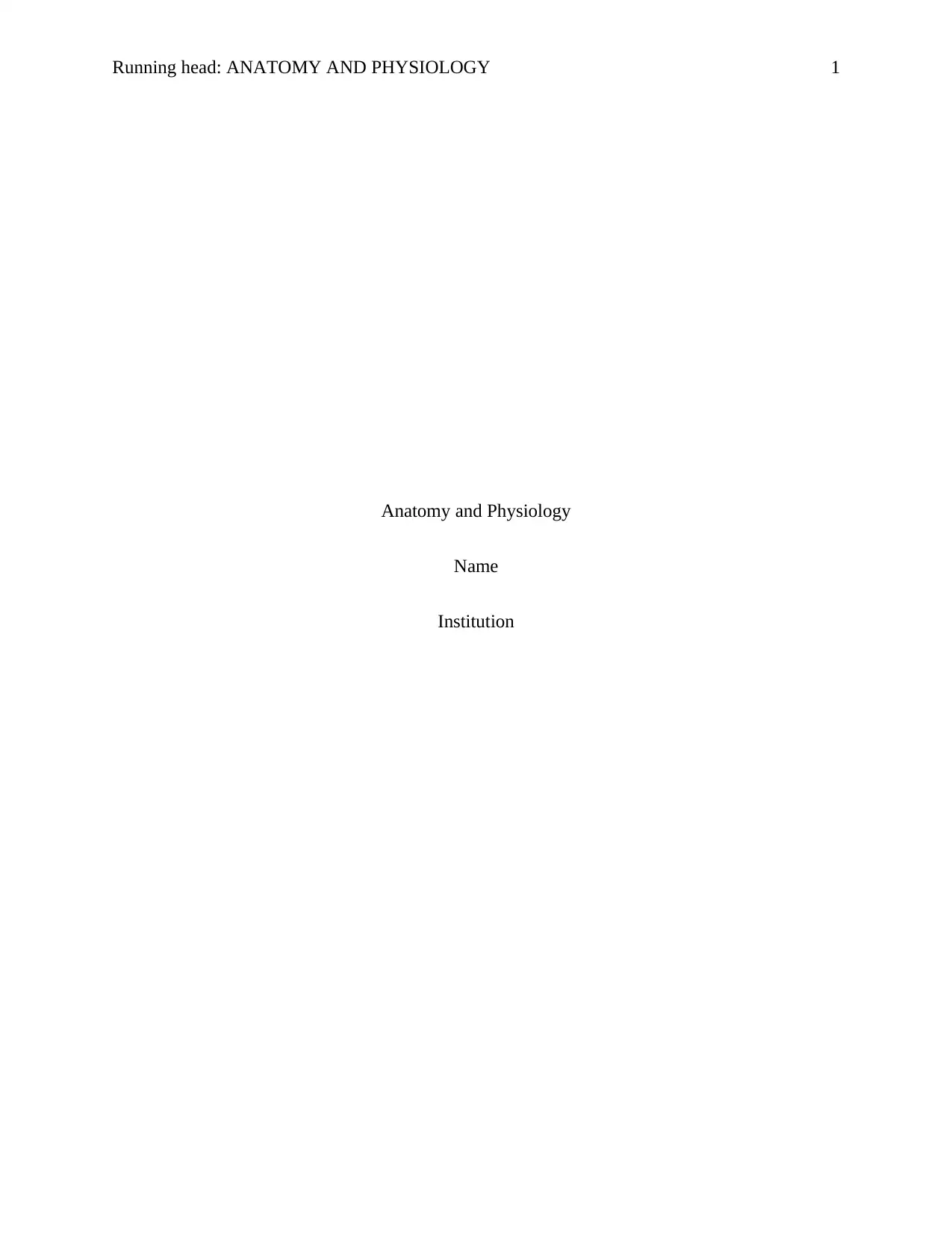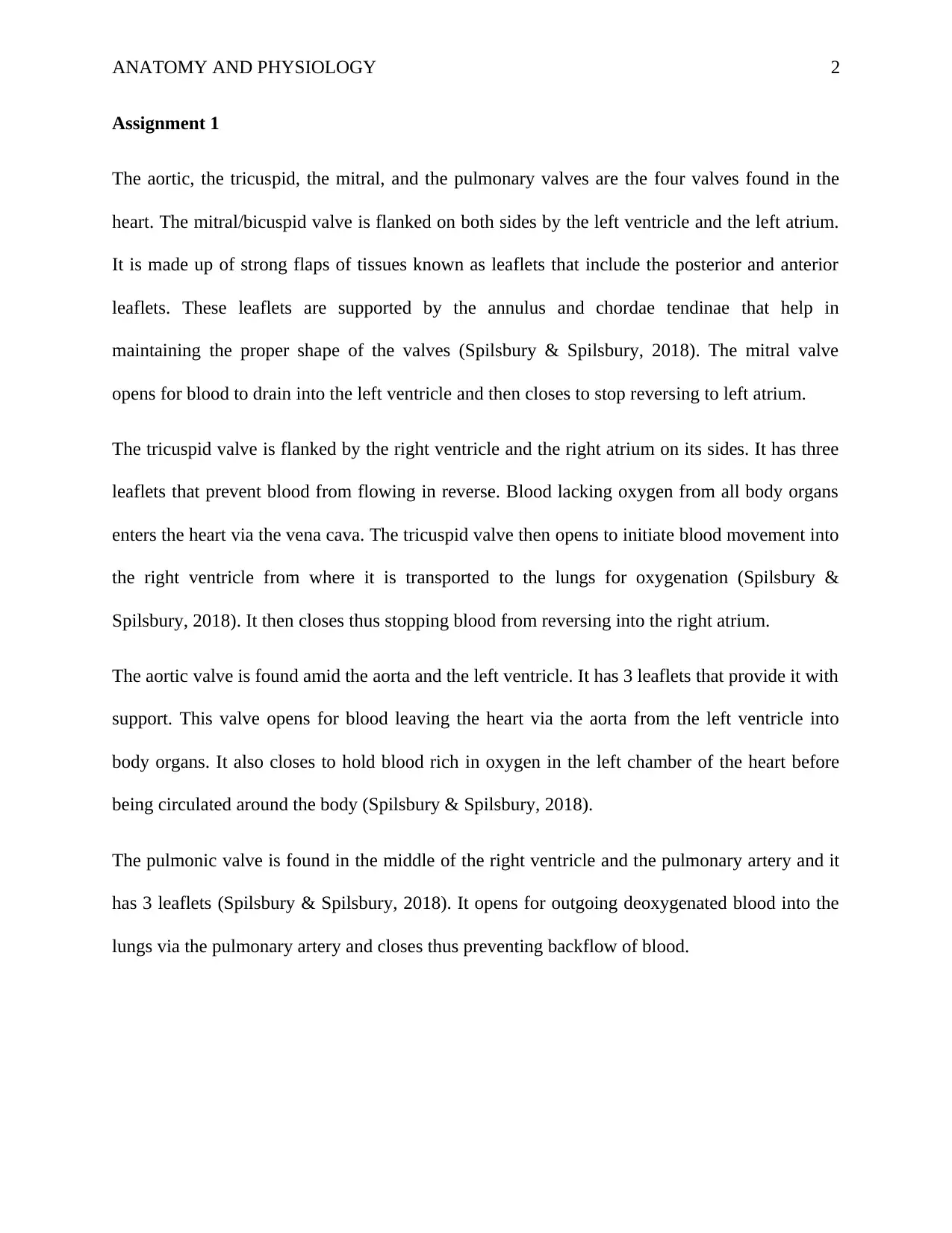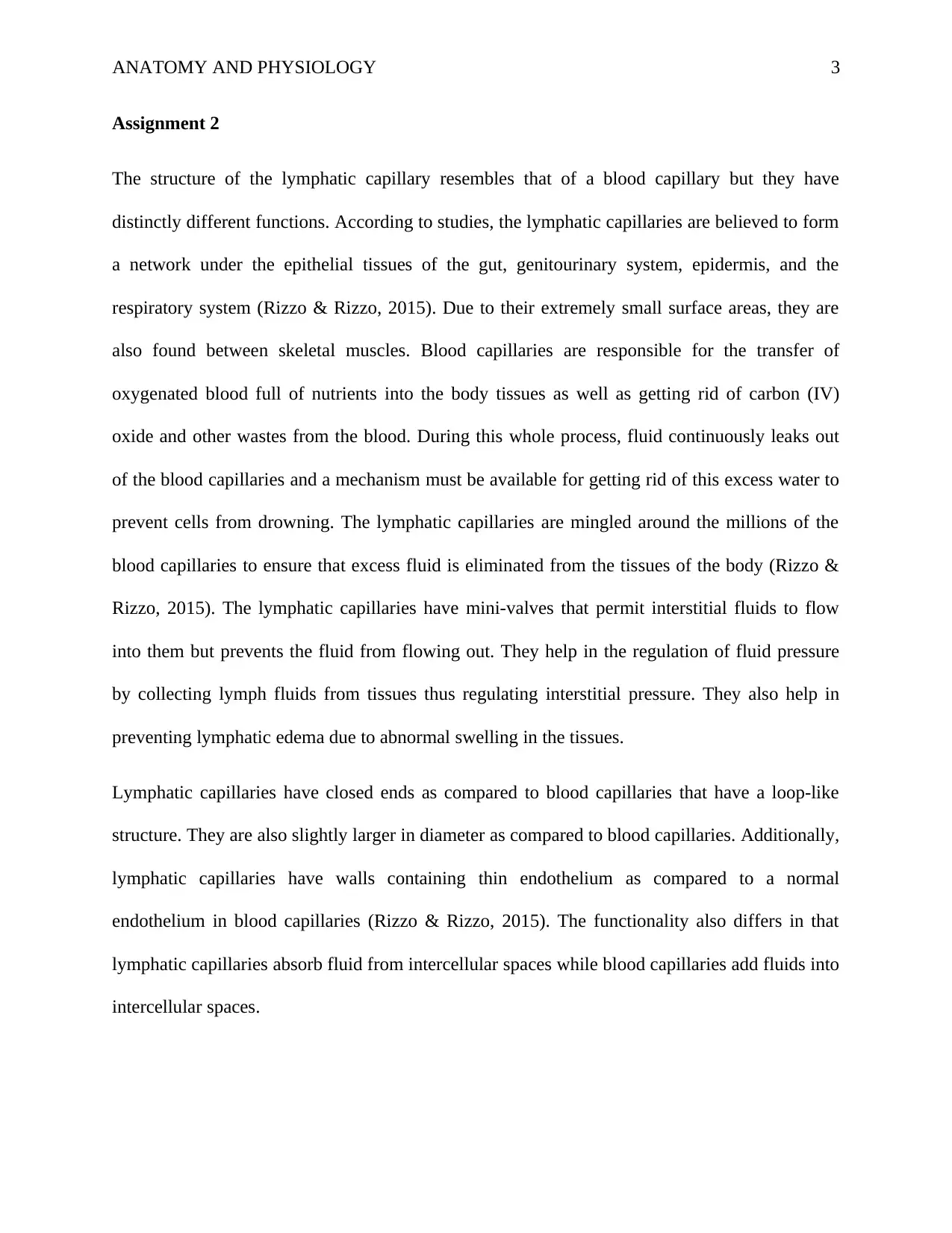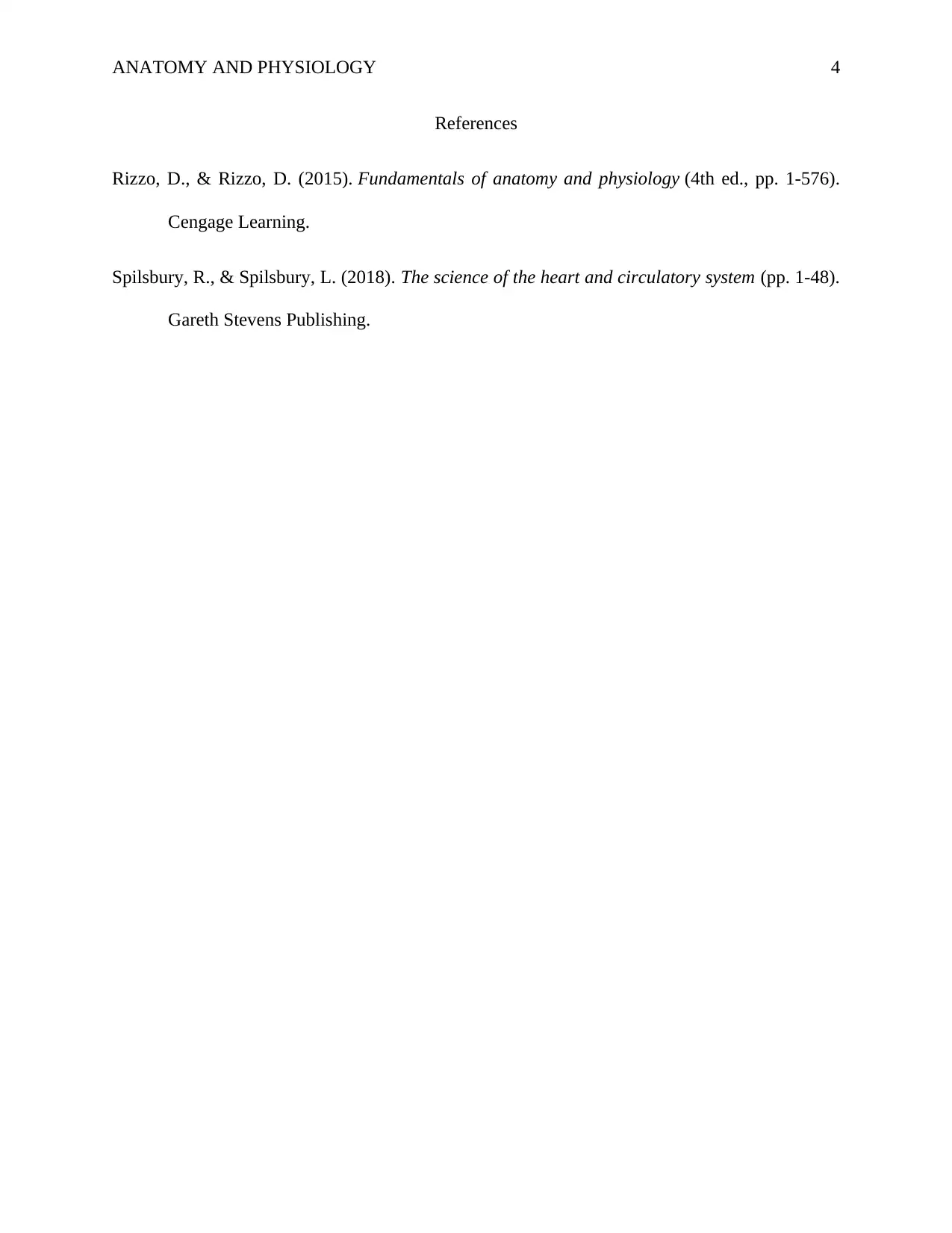Anatomy and Physiology Assignment: Valves and Lymphatic Capillaries
VerifiedAdded on 2022/08/13
|4
|704
|209
Homework Assignment
AI Summary
This assignment delves into the anatomy and physiology of the human heart and lymphatic system. The first part of the assignment describes the four heart valves: the aortic, tricuspid, mitral, and pulmonary valves, detailing their location, structure, and function in regulating blood flow through the he...

Running head: ANATOMY AND PHYSIOLOGY 1
Anatomy and Physiology
Name
Institution
Anatomy and Physiology
Name
Institution
Paraphrase This Document
Need a fresh take? Get an instant paraphrase of this document with our AI Paraphraser

ANATOMY AND PHYSIOLOGY 2
Assignment 1
The aortic, the tricuspid, the mitral, and the pulmonary valves are the four valves found in the
heart. The mitral/bicuspid valve is flanked on both sides by the left ventricle and the left atrium.
It is made up of strong flaps of tissues known as leaflets that include the posterior and anterior
leaflets. These leaflets are supported by the annulus and chordae tendinae that help in
maintaining the proper shape of the valves (Spilsbury & Spilsbury, 2018). The mitral valve
opens for blood to drain into the left ventricle and then closes to stop reversing to left atrium.
The tricuspid valve is flanked by the right ventricle and the right atrium on its sides. It has three
leaflets that prevent blood from flowing in reverse. Blood lacking oxygen from all body organs
enters the heart via the vena cava. The tricuspid valve then opens to initiate blood movement into
the right ventricle from where it is transported to the lungs for oxygenation (Spilsbury &
Spilsbury, 2018). It then closes thus stopping blood from reversing into the right atrium.
The aortic valve is found amid the aorta and the left ventricle. It has 3 leaflets that provide it with
support. This valve opens for blood leaving the heart via the aorta from the left ventricle into
body organs. It also closes to hold blood rich in oxygen in the left chamber of the heart before
being circulated around the body (Spilsbury & Spilsbury, 2018).
The pulmonic valve is found in the middle of the right ventricle and the pulmonary artery and it
has 3 leaflets (Spilsbury & Spilsbury, 2018). It opens for outgoing deoxygenated blood into the
lungs via the pulmonary artery and closes thus preventing backflow of blood.
Assignment 1
The aortic, the tricuspid, the mitral, and the pulmonary valves are the four valves found in the
heart. The mitral/bicuspid valve is flanked on both sides by the left ventricle and the left atrium.
It is made up of strong flaps of tissues known as leaflets that include the posterior and anterior
leaflets. These leaflets are supported by the annulus and chordae tendinae that help in
maintaining the proper shape of the valves (Spilsbury & Spilsbury, 2018). The mitral valve
opens for blood to drain into the left ventricle and then closes to stop reversing to left atrium.
The tricuspid valve is flanked by the right ventricle and the right atrium on its sides. It has three
leaflets that prevent blood from flowing in reverse. Blood lacking oxygen from all body organs
enters the heart via the vena cava. The tricuspid valve then opens to initiate blood movement into
the right ventricle from where it is transported to the lungs for oxygenation (Spilsbury &
Spilsbury, 2018). It then closes thus stopping blood from reversing into the right atrium.
The aortic valve is found amid the aorta and the left ventricle. It has 3 leaflets that provide it with
support. This valve opens for blood leaving the heart via the aorta from the left ventricle into
body organs. It also closes to hold blood rich in oxygen in the left chamber of the heart before
being circulated around the body (Spilsbury & Spilsbury, 2018).
The pulmonic valve is found in the middle of the right ventricle and the pulmonary artery and it
has 3 leaflets (Spilsbury & Spilsbury, 2018). It opens for outgoing deoxygenated blood into the
lungs via the pulmonary artery and closes thus preventing backflow of blood.

ANATOMY AND PHYSIOLOGY 3
Assignment 2
The structure of the lymphatic capillary resembles that of a blood capillary but they have
distinctly different functions. According to studies, the lymphatic capillaries are believed to form
a network under the epithelial tissues of the gut, genitourinary system, epidermis, and the
respiratory system (Rizzo & Rizzo, 2015). Due to their extremely small surface areas, they are
also found between skeletal muscles. Blood capillaries are responsible for the transfer of
oxygenated blood full of nutrients into the body tissues as well as getting rid of carbon (IV)
oxide and other wastes from the blood. During this whole process, fluid continuously leaks out
of the blood capillaries and a mechanism must be available for getting rid of this excess water to
prevent cells from drowning. The lymphatic capillaries are mingled around the millions of the
blood capillaries to ensure that excess fluid is eliminated from the tissues of the body (Rizzo &
Rizzo, 2015). The lymphatic capillaries have mini-valves that permit interstitial fluids to flow
into them but prevents the fluid from flowing out. They help in the regulation of fluid pressure
by collecting lymph fluids from tissues thus regulating interstitial pressure. They also help in
preventing lymphatic edema due to abnormal swelling in the tissues.
Lymphatic capillaries have closed ends as compared to blood capillaries that have a loop-like
structure. They are also slightly larger in diameter as compared to blood capillaries. Additionally,
lymphatic capillaries have walls containing thin endothelium as compared to a normal
endothelium in blood capillaries (Rizzo & Rizzo, 2015). The functionality also differs in that
lymphatic capillaries absorb fluid from intercellular spaces while blood capillaries add fluids into
intercellular spaces.
Assignment 2
The structure of the lymphatic capillary resembles that of a blood capillary but they have
distinctly different functions. According to studies, the lymphatic capillaries are believed to form
a network under the epithelial tissues of the gut, genitourinary system, epidermis, and the
respiratory system (Rizzo & Rizzo, 2015). Due to their extremely small surface areas, they are
also found between skeletal muscles. Blood capillaries are responsible for the transfer of
oxygenated blood full of nutrients into the body tissues as well as getting rid of carbon (IV)
oxide and other wastes from the blood. During this whole process, fluid continuously leaks out
of the blood capillaries and a mechanism must be available for getting rid of this excess water to
prevent cells from drowning. The lymphatic capillaries are mingled around the millions of the
blood capillaries to ensure that excess fluid is eliminated from the tissues of the body (Rizzo &
Rizzo, 2015). The lymphatic capillaries have mini-valves that permit interstitial fluids to flow
into them but prevents the fluid from flowing out. They help in the regulation of fluid pressure
by collecting lymph fluids from tissues thus regulating interstitial pressure. They also help in
preventing lymphatic edema due to abnormal swelling in the tissues.
Lymphatic capillaries have closed ends as compared to blood capillaries that have a loop-like
structure. They are also slightly larger in diameter as compared to blood capillaries. Additionally,
lymphatic capillaries have walls containing thin endothelium as compared to a normal
endothelium in blood capillaries (Rizzo & Rizzo, 2015). The functionality also differs in that
lymphatic capillaries absorb fluid from intercellular spaces while blood capillaries add fluids into
intercellular spaces.
You're viewing a preview
Unlock full access by subscribing today!

ANATOMY AND PHYSIOLOGY 4
References
Rizzo, D., & Rizzo, D. (2015). Fundamentals of anatomy and physiology (4th ed., pp. 1-576).
Cengage Learning.
Spilsbury, R., & Spilsbury, L. (2018). The science of the heart and circulatory system (pp. 1-48).
Gareth Stevens Publishing.
References
Rizzo, D., & Rizzo, D. (2015). Fundamentals of anatomy and physiology (4th ed., pp. 1-576).
Cengage Learning.
Spilsbury, R., & Spilsbury, L. (2018). The science of the heart and circulatory system (pp. 1-48).
Gareth Stevens Publishing.
1 out of 4
Related Documents
Your All-in-One AI-Powered Toolkit for Academic Success.
+13062052269
info@desklib.com
Available 24*7 on WhatsApp / Email
![[object Object]](/_next/static/media/star-bottom.7253800d.svg)
Unlock your academic potential
© 2024 | Zucol Services PVT LTD | All rights reserved.




